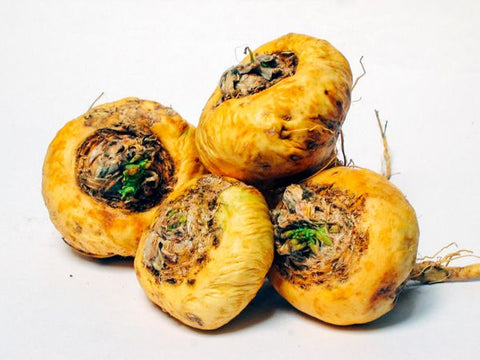What is Maca?
Maca (Lepidium meyenii), also known as Peruvian ginseng (although it has nothing to do with ginseng), is a plant that belongs to the Brassicaceae family, which grows in the central Andes of Peru, above 4,000 meters above sea level. It has been cultivated for more than 2,000 years and up to thirteen varieties have been described, the most studied being the black and the red.
Its shape is small and flattened, its tuberous root (the edible part) resembles a radish and its color is yellow, purple or yellow with purple bands.
Maca is credited with a host of health benefits, which has earned it the nickname “superfood,” but let’s get to know it better.

Types of Maca
According to the extract obtained from maca roots we can find the following types:
Yellow Maca: This is the most common and well-known. Present in 60% of maca crops. It is very rich in nutrients and known as “Natural Viagra”. Present in 25% of the annual harvest.
Red Maca: Antioxidant and antitumor properties.
Black Maca: It is the least common to find, present only in 15% of the annual harvest and is called "maca for men", thanks to its properties in sperm production and mobility, increased libido

Nutritional composition
It is important to note that there are notable differences in nutritional content depending on the author of the analysis and the variety itself, as well as depending on the particularities of the growing soil.
Maca is very energetic, as its main component is carbohydrates. Its potassium, calcium, sodium and iron content is notable. And, among the vitamins, those of group B and vitamin C stand out. Its contribution of essential fatty acids, alkaloids and sterols give it magnificent properties, including antioxidant and cardioprotective properties.

Nutrients
Potassium
This mineral, which is found in vegetables, is particularly prominent in bananas. It is essential for the transmission and generation of nerve impulses, and is involved in muscle contraction, as well as in water balance, both inside and outside the cell. One of the consequences of electrolyte loss due to dehydration can be cramps, so a diet rich in vegetables, fruits, legumes and nuts will help you get enough to prevent cramps.
Calcium
Its intake helps prevent decalcification and osteoporosis. Calcium is responsible for many structural functions of the body's hard and soft tissues, as well as for regulating neuromuscular transmission of chemical and electrical stimuli, cellular secretion and blood coagulation.
Iron
Iron is a mineral necessary for the growth and development of the body. It participates in the production of hormones and connective tissue, as well as in the production of hemoglobin, among its most important functions.

B vitamins
Maca contains significant amounts of the B complex, such as B1 and B2, which benefit the nervous and immune systems.
Vitamin C
Vitamin C is an antioxidant that helps fight free radicals that are produced in the body for different reasons and are harmful to the body. In addition, it is necessary for the growth and repair of tissues, forming proteins that make up the skin, tendons, ligaments... It helps in the healing of wounds and participates in the absorption of iron.
Essential fatty acids
Essential fatty acids (EFAs) are vital nutritional components, as they are necessary to carry out countless functions such as, for example, reducing the accumulation of lipids in the arteries (lowering LDL cholesterol and increasing HDL) and promoting the synthesis of hemoglobin. They are also components of cell membranes and have a vasodilatory action that helps lower blood pressure. They also have an anti-inflammatory and protective action on different types of cancer, especially breast cancer. As their name indicates, they are essential nutrients, because our body cannot synthesize them, so it is important to ingest them with our diet.
Maca flour, rich in minerals
In Andean countries, maca was considered an important source of calcium in the traditional diet. We find up to 500 mg of this mineral in 100 grams of maca flour.
Taking one tablespoon of dehydrated maca powder (about 10 g) will be enough to provide you with 75% of the recommended daily amount of iron, 4% of calcium and 3% of magnesium. To ensure that you absorb the iron well, it is best to accompany maca with fruits rich in vitamin C.

Health Benefits
Antioxidant : Several studies show that maca has antioxidant power, helping to neutralize free radicals (which cause, among other things, cancer, cardiovascular diseases and diabetes) present in the blood. (Zhaa et al., 2014; Yao et al., 2012).
Fertility: One of the major claims made about maca is that it improves fertility. Studies have shown that this food contains compounds with functions similar to those of testosterone in terms of biological activities (Eddouks et al., 2005; Gonzales et al., 2002). In 2001, the first report was obtained showing the benefits of maca in improving spermatogenesis in male rats. Other subsequent studies indicated similar results, but although there is data linking sexual desire, fertility and spermatogenesis with maca consumption, there is not enough scientific evidence.
Sexual desire : In recent years, several researchers have become interested in the benefits of foods for treating erectile dysfunction, which is the inability to maintain an erection firm enough to achieve satisfactory sexual intercourse.

A study (Gonzales et al., 2002) was conducted on 56 healthy men (21-56 years of age) in which they subjectively self-evaluated themselves for 12 weeks with a maca treatment; subsequently, the result showed an increase in sexual desire of up to 42.2%, which was significantly different from the experiment applied with placebo. This was confirmed by another study (Kamohara et al. 2014) as they reached the same result when experimenting with 14 men.
Menopause: Maca has been used since ancient times to counteract anemia, infertility problems and hormonal imbalance in the female body (Hudson, 2008; Lee et al., 2011). However, to date, it has not been possible to conclude that it has benefits during menopause, since previous studies with positive results are not reliable, as the type of maca used is unknown, as is the dose that would be needed to confirm that maca helps counteract the symptoms of menopause (Lee et al., 2011).
Energizing : A study was conducted on 8 experienced and trained male cyclists for two weeks, who were given a supplement of 2,000 mg/day of maca extract. The aim was to investigate the effect of this supplement on endurance performance and sexual desire, which was demonstrated (Spector et al., 1996; Stone et al., 2009).
Maca flour, rich in minerals
In Andean countries, maca was considered an important source of calcium in the traditional diet. We find up to 500 mg of this mineral in 100 grams of maca flour.
Taking one tablespoon of dehydrated maca powder (about 10 g) will be enough to provide you with 75% of the recommended daily amount of iron, 4% of calcium and 3% of magnesium. To ensure that you absorb the iron well, it is best to accompany maca with fruits rich in vitamin C.

How to take it
You can easily find maca powder or maca flour, which is nothing more than dehydrated and ground maca. Another way to consume it is in extract capsules.
To take maca powder: The recommended amount is 5 to 15 grams per serving (5 grams for children). Simply boil it with water or milk to make drinks, or mix it with fruit and vegetable juices, sauces or smoothies. With vegetable milk you can prepare a comforting maca latte.
To take the extract capsules: They are taken as a supplement or in nutritional treatments. Doses vary between 3 and 6 capsules per day (each usually contains around 500 mg)





Comments (0)
There are no comments for this article. Be the first one to leave a message!